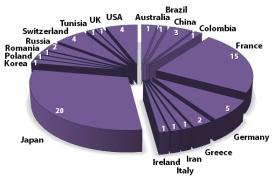

09/28/2009

In August 2009, Tohoku University’s Advanced Institute for Materials Research hosted an international workshop on bulk metallic glasses (BMGs) at the Maison du Tourism in Grenoble, France. The workshop, attended by 70 researchers from 20 countries, was a great success thanks to facilitation by Alain Reza Yavari, a professor of the Institut Polytechnique de Grenoble who concurrently holds the position of principal investigator at the WPI-AIMR.
The topics of the 52 oral presentations and 13 posters varied from basic research to application with a focus on the mechanical properties of BMGs. Many researchers reported their attempts to unveil the origin of BMG’s strengths compared to crystals. The central topic was the ‘shear bands’ that arise when a BMG is subject to plastic deformation. Individual presentations included the analysis of atomic bonding using synchrotron diffraction, observation of BMGs by scanning electron microscopy, and simulations of atomic bonding in BMGs. In particular, there were active discussions on cooperative phenomena, such as shear transformation zones and microscopic formation of shear bands in BMGs.
Understanding of the mechanical properties is the basis of all applications of BMGs, and elucidation of shear band phenomena is key. In the past, the primary feature of single-crystal silicon for semiconductors was dislocation: for BMGs, it is shear bands. To enhance the degree of freedom for processing, it is desirable to enhance the temperature range of supercooling just before vitrification, that is, to freely control the glass-transition point. To this end, the number of elements forming high-quality BMGs and the elemental ratio are important factors.
Researchers are making progress in discovering the compositions that form BMGs and unveiling the guiding principle. Starting from the eutectic phase diagram of three elements, and using the atomic radius and electro-negativity as guides, participants in the discussions consolidated their ideas by sharing their experiments results.

At the end of the workshop, Yavari moderated comprehensive discussions by all the participants. Akihisa Inoue, president of Tohoku University, partook in the discussions and outlined the WPI-AIMR’s objectives and organizational structure. Inoue reminded participants to be mindful of the critical evaluation of high-quality research results, interdisciplinary or ‘fusion’ research, and the application of research outcomes by the WPI-AIMR, while expressing his resolve to make WPI-AIMR more global and attract a greater number of distinctive young researchers.
The University of Cambridge professor A. L. Greer pointed out that sustainability will be an important concept when proceeding with applications. He added that BMGs could be applied for maintaining the environment, for clean air and water and energy-saving technologies using BMGs in magnetic applications, medicine and micro-devices.
August 29, 2009
In Grenoble, Hiroshi Komatsu, professor emeritus of Tohoku University